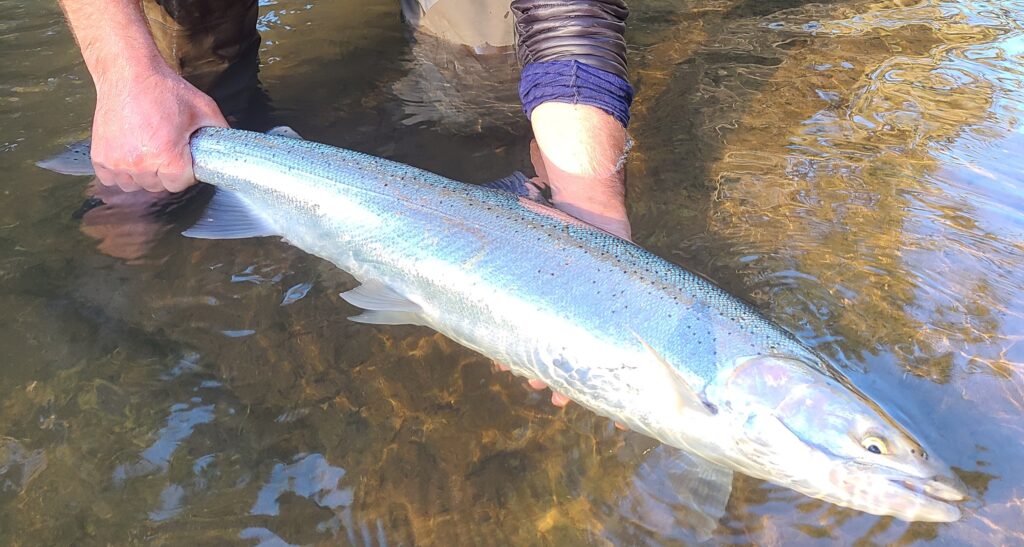
Welcome to our inaugural quarterly newsletter that we will share exclusively with you — our most stalwart Wild Steelhead Initiative supporters. We have two primary objectives with this newsletter: keeping you informed about what we are working on and recent developments in wild steelhead management and science; and providing practical information, such as steelhead run forecasts from Alaska, BC and the Lower 48, to help you plan your time on the water.
I’d like to start by expressing, on behalf of the entire Wild Steelhead Initiative team, our deep appreciation for your financial support. Many of you have been consistent donors since we launched the Initiative in 2014, and I can say without a doubt that you are the reason we have been able to achieve significant outcomes for wild steelhead conservation over the past decade, including:
- Ending sport harvest of wild steelhead on the Olympic Peninsula’s cherished westside rivers, the Queets, Hoh, Sol Duc, Bogachiel and Calawah
- Reopening a catch-and-release season on the Skagit River with rigorous monitoring and conservation thresholds
- Creating a first of its kind steelhead management “portfolio” in Puget Sound, with some rivers managed exclusively for wild steelhead and other, more degraded rivers where hatcheries will provide fishing opportunity
- Protecting 100,000 acres of the fabled North Umpqua through federal legislation establishing the Frank and Jeanne Moore Wild Steelhead Sanctuary
- Removing four dams and opening more than 400 miles of steelhead habitat in the Klamath River Basin
- Protecting 9.3 million acres of southeast Alaska’s Tongass National Forest, including its most productive wild steelhead rivers, from clearcut logging and roadbuilding
Every one of these successful efforts involved partnerships. If someone tells you that their organization was solely responsible for major achievements such as the ones noted above, don’t believe them. Our list of partners is long, including other non-profit conservation and fishing organizations, Tribes, state fish and wildlife agencies and commissions, and federal and state legislators. We are grateful to all.
But I believe it is also fair to say that “but for” TU’s Wild Steelhead Initiative team engaging, many of these achievements would not have happened. The Initiative team includes top-shelf scientists, policy advocates, organizers and communications experts. We work in Washington, Oregon, California, Idaho and Alaska, as well as in Washington D.C., and our community of supporters — Wild Steelheaders United – is X strong and growing.
One key feature that sets TU’s Wild Steelhead Initiative apart from other organizations is that we pursue improvements in wild steelhead management, not just try to prevent bad things from happening. Relatively speaking, it is easier to oppose an ill-conceived action than to develop an affirmative agenda and see it through to fruition. Yet the latter is what we need to do if we are to achieve our vision that includes both wild steelhead conservation and better angling opportunity, and it takes resources and time. But as the progress highlighted above demonstrates, it is possible to move the needle in the right direction.
We are proud of our accomplishments over the past 10 years, but we have much more we need to achieve if we are to improve the abundance and health of wild steelhead populations while also increasing responsible angling opportunity. CONSIDER INTRODUCING RAISE HERE AND THEN STATING THE STUFF BELOW AS NEAR-TERM GOALS. With your continued support we are confident that we will build on our success to date by:
- Obtaining a new fisheries management plan for westside rivers on the Olympic Peninsula designed to strengthen wild steelhead populations while providing consistent angling opportunity
- Partnering with Tribes and state steelhead managers to develop steelhead management plans for the Klamath and Elwha basins that prioritize wild steelhead restoration and sustainable fishing opportunities
- Removing two large dams in the headwaters of California’s Eel River, opening 300 stream miles including the best summer steelhead habitat
- Skagit River hydropower relicensing




















